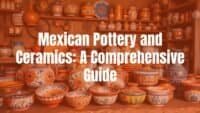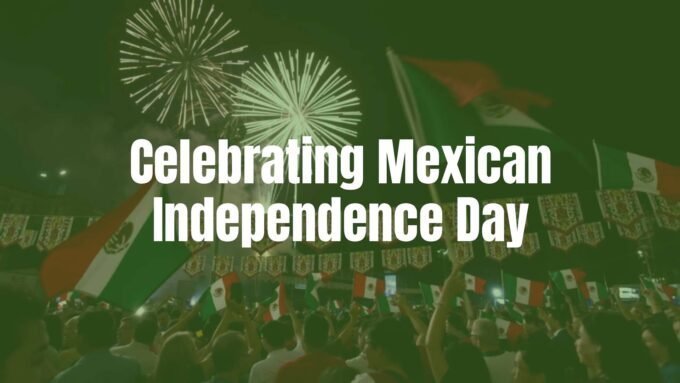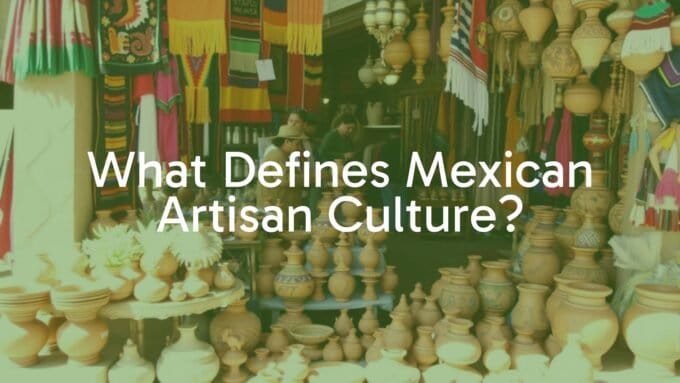Handmade Mexican jewelry is more than an accessory; it is art you can wear. Each piece carries history, culture, and the skill of makers who pass their craft from one generation to the next. Unlike factory items, these pieces feel personal and unique, with designs that reflect Mexico’s rich heritage. This guide looks at traditions, materials, techniques, and the reasons people around the world value these special pieces.

What Is Handmade Mexican Jewelry?
Handmade Mexican jewelry is created by individual makers or small workshops using time-tested methods and designs rooted in local culture. These pieces are not made on assembly lines. Each one shows the vision and handwork of its maker. From the fine silverwork of Taxco to the bright beadwork of the Huichol communities, the range of styles is wide and remarkable.
The small differences from piece to piece are part of the charm. They are signs of real handwork, not mistakes. No two items are exactly the same, which makes every piece feel personal. Families and communities keep these methods alive, preserving a long and proud craft tradition.
How Is Handmade Jewelry Different from Mass-Produced Mexican Jewelry?
Handmade and mass-produced jewelry differ in many ways beyond looks. Factory items focus on speed, sameness, and low cost, which often leads to less character and cheaper parts. They may copy classic designs but miss the fine details and quality that handmade work offers-like the difference between a carefully painted original and a quick print.
Handmade pieces show careful attention to detail, better materials, and many hours of skilled work. Every hammer mark, stone setting, and bead placement reflects real craft. Factories often use low-cost alloys and synthetic stones. Handmade items usually feature sterling silver, real gemstones, and natural materials, which adds lasting beauty and value.
What Are the Traditions and History Behind Mexican Jewelry?
Mexican jewelry has deep roots that go back long before Europeans arrived. The Aztecs, Mayans, and Mixtecs were expert jewelers who made intricate pieces from gold, silver, jade, and obsidian. These items often had spiritual, social, and political roles, worn by leaders and used in ceremonies.
After the Spanish conquest, new techniques and materials mixed with native traditions to create a blended style. Silver became central as large mines were developed across Mexico. Over time, older and newer methods grew together, and many regions formed their own distinct styles.
Influence of Indigenous and Colonial Styles
Indigenous makers developed advanced metal and stone work, seen in Mayan jade carvings and Mixtec gold pieces. Designs often showed animals, gods, and geometric forms with deep meaning.
The Spanish brought new tools, European designs, and large-scale silver work. Techniques like filigree and repoussé spread and were adapted by local makers. Christian symbols and European floral patterns joined with native motifs, creating a rich blend that still shapes many designs today.
Common Symbols and Motifs in Mexican Jewelry
Many pieces use symbols that tell stories and carry meaning. Common themes include:
- Flowers (roses, dahlias): beauty and love
- Animals (eagles, serpents, jaguars): power, wisdom, protection
- Sun and moon: balance and order
- Religious symbols: crosses, the Virgin, saints
- Geometric patterns: inspired by ancient buildings and textiles

What Materials Are Used in Handmade Mexican Jewelry?
Materials reflect Mexico’s land and culture. Makers choose them for looks, meaning, and durability. Good materials help create authentic pieces that last.
From precious metals to clay and natural fibers, the range is broad. High-quality components are a key sign of real handmade work, unlike the lower-grade parts often found in factory items.
| Material | Key Traits | Common Uses/Regions |
|---|---|---|
| Sterling silver (.925) | Bright shine, strong yet workable | Taxco; rings, earrings, bracelets, necklaces |
| Gemstones (turquoise, amethyst, jade, obsidian, amber) | Natural color, unique patterns | Across Mexico; often paired with silver |
| Beads (glass, seeds, wood, shells) | Vivid color, light weight | Huichol beadwork; necklaces, earrings |
| Clay, leather, textiles, feathers | Hand-painted, textured, organic look | Folk art jewelry in several regions |
Sterling Silver in Mexican Jewelry
Sterling silver is a hallmark of Mexican jewelry, especially linked with the silver town of Taxco. It shines, shapes well, and holds up to daily wear, which makes it great for detailed designs. Mexican silversmiths are well known for turning silver into beautiful pieces of all kinds.
Silverwork in Mexico goes back centuries, growing from native skills to advanced methods used today. Sterling silver (92.5% pure) balances purity with strength, perfect for fine work without being too soft. The solid feel and cool touch are good signs of real quality.
Use of Gemstones and Semi-Precious Stones
Many pieces include colorful stones that add character. Turquoise is loved for its blue-green color and is often linked with protection and luck. You will also see amethyst, obsidian, jade, and amber, which reflect Mexico’s geology.
These stones often carry cultural meaning, valued by native groups for thousands of years. Makers cut, polish, and set them with care, often pairing them with silver to create strong contrast. Natural variations in each stone make every piece unique.
Incorporation of Beads, Clay, and Other Natural Materials
Mexican makers also use many other natural materials. Beads of glass, seeds, wood, and shells are key to several styles, especially Huichol work, where patterns share stories from their ancestors.
Clay appears in hand-painted pieces with classic motifs. Leather, textiles, and feathers bring texture and color and connect the jewelry to nature. These choices show both creativity and respect for tradition.
Which Techniques Are Used in Creating Handmade Mexican Jewelry?
Making handmade Mexican jewelry takes skill, patience, and steady hands. Old methods passed down over time shape raw materials into detailed pieces. Knowing these processes helps you value the work that goes into each item.
Techniques range from fine wirework to bold raised metal designs. This is careful, precise craft that calls for both technique and an artistic eye.
Filigree
Filigree uses very thin wires of silver or gold twisted into lace-like patterns. The wires are soldered onto a base or joined to form open designs. The result is light, airy jewelry with delicate detail.
Brought by the Spanish and embraced by Mexican makers, filigree often shows flowers, scrolls, and geometric shapes. It highlights steady hands and careful work, creating pieces that feel both classic and current.
Repoussé (Metal Embossing)
Repoussé shapes soft metal, often silver, by hammering from the back to raise designs on the front. The maker then refines the details from the front with special tools. This creates low-relief, three-dimensional patterns that you can feel.
Mexican artists use repoussé to show religious figures, nature themes, and intricate patterns. It takes strength, precision, and a clear plan to give the metal form and depth.
Enameling and Stone Setting
Enameling fuses powdered glass to metal at high heat to create smooth, colorful surfaces. Methods include cloisonné (wires form small cells that hold different colors) and plique-à-jour (enamel fills open spaces for a stained-glass effect). Enamel adds strong color and a glossy finish.
Stone setting fixes gems securely in metal. Common methods are bezel (a rim holds the stone), prong (small claws grip it), and channel (stones sit in a groove). Together, enamel and stone setting create bright, eye-catching pieces that show both metal skill and the beauty of the stones.

What Are the Most Iconic Types of Handmade Mexican Jewelry?
Many regions in Mexico have their own jewelry traditions. The range is wide and loved by collectors. Learning about these styles gives a clear look at the country’s creative spirit.
From a famous silver town to communities that keep ancient crafts alive, each style has its own story, methods, and materials. These pieces carry the identity of the places they come from.
Taxco Silver Jewelry
Taxco, a mountain town in Guerrero, is closely tied to sterling silver. Known as the “Silver Capital of Mexico,” its modern fame began in the 1930s when William Spratling opened workshops that mixed native motifs with Art Deco and modern design. His ideas helped shape generations of makers.
Taxco pieces often carry a .925 mark and are known for high quality and inventive styles. You will find bold shapes, fine filigree, and stones such as amethyst, obsidian, and turquoise. Owning Taxco silver means holding a piece of Mexican design history and the work of skilled hands.
Huichol Beadwork
The Huichol people, based in the Sierra Madre Occidental, create bright beadwork with deep spiritual meaning. Using tiny glass beads and a mix of beeswax and pine resin, they form detailed patterns that show sacred symbols, animals, and figures from their beliefs.
Necklaces, bracelets, earrings, and masks carry stories of visions, nature, and tradition. The patterns can be complex and abstract, linking the wearer to a living culture.

Oaxacan and Mayan Pieces
Oaxaca is known for gold filigree with designs inspired by ancient motifs, flowers, and religious themes. Makers often add small pearls or coral, creating elegant pieces tied to Zapotec and Mixtec roots.
In the Yucatán Peninsula and Chiapas, Mayan communities continue long-standing jewelry practices. These pieces often use jade-highly valued by their ancestors-along with shells, wood, and silver. Designs feature glyphs, calendar symbols, deities, and nature, with earthy tones and careful carvings.
How to Identify Authentic Handmade Mexican Jewelry
There are many copies on the market, so learning how to spot real handmade Mexican jewelry is important. True pieces support art, culture, and the makers. With a trained eye and some knowledge, you can pick items that are both beautiful and meaningful.
Authenticity involves materials, workmanship, and a clear link to tradition. Paying attention to common signs helps you tell real craft from factory replicas.
What Are Common Signs of Authenticity?
- Look for a .925 stamp on silver to show sterling content.
- Many Taxco makers add an artisan mark or registry number.
- Check weight and feel: sterling silver is heavier and cool to the touch.
- Expect small variations that show handwork, not perfect uniformity.
- Stones should be set cleanly; filigree and beadwork should show careful detail.
- Examine the back: quality pieces look well finished on all sides.
How to Avoid Mass-Produced Imitations
- Be cautious of very low prices for silver or gemstone pieces.
- Watch for “nickel silver” (contains no real silver) or thin plating that wears off.
- Check that color and finish are consistent, without peeling or odd tones.
- Read product details for materials, place of origin, and maker info.
- Buy from respected sources: known artisans, good galleries, or well-reviewed shops.
Why Should You Buy Handmade Mexican Jewelry?
Buying handmade Mexican jewelry is a way to value culture, make ethical choices, and wear something unique. These pieces connect you to Mexico’s heritage and the people who keep these skills alive.
Beyond looks, your purchase supports makers and their communities. It shows you value real craft in a time when many things are made in large factories.
Supporting Artisans and Local Communities
Your purchase helps makers and their families earn a steady living. It lets them continue their craft, invest in tools and training, and pass skills on to the next generation. Many come from long lines of jewelers, and your support keeps these traditions going.
This also protects cultural practices that might fade with industrial growth. Choosing handmade values human skill and creativity over mass production.
Preserving Cultural Heritage Through Jewelry
Handmade Mexican jewelry carries stories, symbols, and methods that span centuries. By buying and wearing these pieces, you help keep this heritage alive and relevant.
Wearing handmade pieces shares Mexican culture with others. It honors traditional craft and spreads knowledge about the art and history within each design.
Where Can You Find and Purchase Genuine Handmade Mexican Jewelry?
If you want to find real handmade pieces, several paths can lead you to authentic work and direct contact with makers. A smart approach helps you buy items with real roots and clear origin.
Whether you enjoy busy markets or prefer shopping online, knowing good sources makes a big difference. Aim for pieces that are beautiful, ethical, and true to Mexican craft.
Markets and Artisan Fairs in Mexico
Visiting markets and fairs in Mexico is one of the best ways to find real handmade jewelry. Towns like Taxco (silver), Oaxaca (filigree and folk crafts), and San Miguel de Allende have active artisan scenes where you can meet makers and see the work up close.
You may see artisans at work and hear the stories behind their designs. Haggling can be part of the process, but do it with respect. Fairs in larger cities often offer curated selections of high-quality goods. Buying directly builds trust and gives you a deeper link to the culture and the people behind the pieces.
Online Shops and Trusted Retailers
If you can’t travel, reputable online stores and retailers can help you find genuine work. Look for clear details about origin, materials, and techniques, and learn about the artisans when possible. Customer reviews and fair return policies signal a trustworthy seller.
Independent boutiques and galleries also import authentic pieces, often working with artisan groups. These shops usually know the craft well and can explain the background of each item. Choose sources that value authenticity, ethical sourcing, and real artistry.
How to Care for and Store Handmade Mexican Jewelry
Handmade pieces use varied materials and detailed work, so they need specific care to stay in good shape. Good cleaning and storage habits help them last and keep their shine.
Different materials need different care. Simple steps can protect your pieces and help you keep showing the best of Mexican craft.
Cleaning Methods for Silver and Beaded Jewelry
For sterling silver, regular light cleaning helps prevent tarnish. Use a soft polishing cloth made for silver to remove light discoloration. For heavier tarnish, use a mild silver cleaner or a paste of baking soda and water. Apply gently with a soft cloth, rinse with warm water, and dry fully with a clean cloth.
Beaded pieces, especially Huichol items set with wax and resin, need gentle care. Do not soak them or use harsh chemicals. Use a soft, dry brush (like a clean makeup brush) to remove dust. For small spots, a barely damp cloth can help; dry the piece quickly and fully. Handle with care to avoid breaks.
Storage Tips to Prevent Tarnish and Damage
Good storage helps keep jewelry in great condition. For silver, use airtight bags or boxes with anti-tarnish strips to slow oxidation. Store in a cool, dry place away from sunlight and moisture. Keep silver separate from other metals to reduce tarnish.
Store delicate beadwork and natural-material pieces apart to avoid tangles and scratches. Lay necklaces flat or hang them to prevent kinks. Keep all pieces away from heat, direct sun, and damp air, which can harm wood, seeds, and resin. Avoid contact with chemicals, perfumes, lotions, and chlorinated water to prevent color changes and damage.













Leave a comment